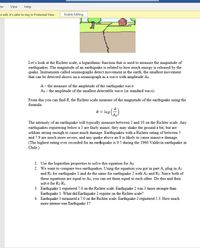
Calculus: Early Transcendentals
8th Edition
ISBN: 9781285741550
Author: James Stewart
Publisher: Cengage Learning
expand_more
expand_more
format_list_bulleted
Question
I need help with 1 and 2 thank you so much!!

Transcribed Image Text:ew
View
Help
co edit, it's safer to stay in Protected View.
Enable Editing
Let's look at the Richter scale, a logarithmic function that is used to measure the magnitude of
earthquakes. The magnitude of an earthquake is related to how much energy is released by the
quake. Instruments called seismographs detect movement in the earth; the smallest movement
that can be detected shows on a seismograph as a wave with amplitude Ao.
A- the measure of the amplitude of the earthquake wave
Ao – the amplitude of the smallest detectable wave (or standard wave)
From this you can find R, the Richter scale measure of the magnitude of the earthquake using the
formula:
R = log
The intensity of an earthquake will typically measure between 2 and 10 on the Richter scale. Any
earthquakes registering below a 5 are fairly minor; they may shake the ground a bit, but are
seldom strong enough to cause much damage. Earthquakes with a Richter rating of between 5
and 7.9 are much more severe, and any quake above an 8 is likely to cause massive damage.
(The highest rating ever recorded for an earthquake is 9.5 during the 1960 Valdivia earthquake in
Chile.)
1. Use the logarithm properties to solve this equation for Ao.
2. We want to compare two earthquakes. Using the equation you got in part A, plug in A1
and Ri for earthquake 1 and do the same for earthquake 2 with A2 and R2. Since both of
these equations are equal to Ao, you can set them equal to each other. Do this and then
solve for R2-R1.
3. Earthquake 1 registered 7.0 on the Richter scale. Earthquake 2 was 3 times stronger than
Earthquake 1. What did Earthquake 2 register on the Richter scale?
4. Earthquake 1 measured a 7.0 on the Richter scale. Earthquake 2 registered 5.3. How much
more intense was Earthquake 1?
Expert Solution
This question has been solved!
Explore an expertly crafted, step-by-step solution for a thorough understanding of key concepts.
Step by stepSolved in 4 steps

Knowledge Booster
Learn more about
Need a deep-dive on the concept behind this application? Look no further. Learn more about this topic, calculus and related others by exploring similar questions and additional content below.Similar questions
- I only need answers to the 3 unanswered questionsarrow_forwardAlex's Evil Twin wishes to steal 18 piece of candy from the 5 kids in his neighborhood. However, George only has 15 pieces of candy (All pieces of candy are identical, but we can tell the kids apart) How many ways are there for Alex's Evil Twin to steal the candy?arrow_forwardSuppose Allan is going to build a playlist that contains 7 songs. In how many ways can Allan arrange the 7 songs on the playlist? Allan can arrange the 7 songs on the playlist in different ways.arrow_forward
arrow_back_ios
arrow_forward_ios
Recommended textbooks for you
 Calculus: Early TranscendentalsCalculusISBN:9781285741550Author:James StewartPublisher:Cengage Learning
Calculus: Early TranscendentalsCalculusISBN:9781285741550Author:James StewartPublisher:Cengage Learning Thomas' Calculus (14th Edition)CalculusISBN:9780134438986Author:Joel R. Hass, Christopher E. Heil, Maurice D. WeirPublisher:PEARSON
Thomas' Calculus (14th Edition)CalculusISBN:9780134438986Author:Joel R. Hass, Christopher E. Heil, Maurice D. WeirPublisher:PEARSON Calculus: Early Transcendentals (3rd Edition)CalculusISBN:9780134763644Author:William L. Briggs, Lyle Cochran, Bernard Gillett, Eric SchulzPublisher:PEARSON
Calculus: Early Transcendentals (3rd Edition)CalculusISBN:9780134763644Author:William L. Briggs, Lyle Cochran, Bernard Gillett, Eric SchulzPublisher:PEARSON Calculus: Early TranscendentalsCalculusISBN:9781319050740Author:Jon Rogawski, Colin Adams, Robert FranzosaPublisher:W. H. Freeman
Calculus: Early TranscendentalsCalculusISBN:9781319050740Author:Jon Rogawski, Colin Adams, Robert FranzosaPublisher:W. H. Freeman
 Calculus: Early Transcendental FunctionsCalculusISBN:9781337552516Author:Ron Larson, Bruce H. EdwardsPublisher:Cengage Learning
Calculus: Early Transcendental FunctionsCalculusISBN:9781337552516Author:Ron Larson, Bruce H. EdwardsPublisher:Cengage Learning

Calculus: Early Transcendentals
Calculus
ISBN:9781285741550
Author:James Stewart
Publisher:Cengage Learning

Thomas' Calculus (14th Edition)
Calculus
ISBN:9780134438986
Author:Joel R. Hass, Christopher E. Heil, Maurice D. Weir
Publisher:PEARSON

Calculus: Early Transcendentals (3rd Edition)
Calculus
ISBN:9780134763644
Author:William L. Briggs, Lyle Cochran, Bernard Gillett, Eric Schulz
Publisher:PEARSON

Calculus: Early Transcendentals
Calculus
ISBN:9781319050740
Author:Jon Rogawski, Colin Adams, Robert Franzosa
Publisher:W. H. Freeman


Calculus: Early Transcendental Functions
Calculus
ISBN:9781337552516
Author:Ron Larson, Bruce H. Edwards
Publisher:Cengage Learning